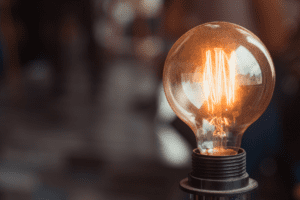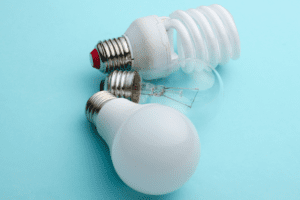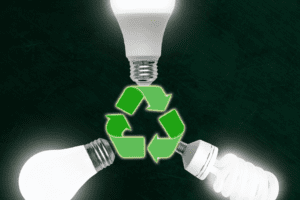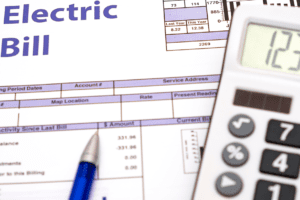As a non-profit organization that always tries to promote a more sustainable lifestyle, We understand the importance of energy efficiency. By using less energy, We can not only save money on our utility bills but also decrease our carbon footprint and reduce our dependence on fossil fuels. One simple way we found to improve energy efficiency in our office is by switching to LED or CFL light bulbs. These bulbs use significantly less energy than traditional incandescent bulbs and have a much longer lifespan. In this article, I will explore the benefits of LED and CFL light bulbs, provide a step-by-step guide on switching to these bulbs, and discuss other ways to improve energy efficiency in our homes. Our goal is to help you understand the importance of energy efficiency in sustainable living and show you how easy it can be to make small changes that can have a big impact.

Benefits of LED and CFL light bulbs
- Lower power consumption: One of the main benefits of LED and CFL light bulbs that we found is their energy efficiency. These bulbs use significantly less energy than traditional incandescent bulbs, so we can save money on electricity bills by switching to them. For example, an LED bulb with the same brightness as a 60-watt incandescent bulb will only use around 10-15 watts of power. This can add up to significant savings for us over time.
- Longer lifespan: Another benefit of LED and CFL light bulbs that we found is their longer lifespan. While an incandescent bulb typically lasts for around 1,000 hours, an LED bulb can last for up to 25,000 hours. This means we’ll have to replace the bulb much less frequently, which saves us time and money. Additionally, because they last longer, they will have less waste and environmental impact. This is one of the reasons why we found LED bulbs to be a more sustainable option than traditional incandescent bulbs.

- It’s worth noting that, while both LED and CFL bulbs have these benefits, We found that LED bulbs tend to be more efficient and last even longer than CFLs. So if you want to maximize energy savings and lifespan, you may want to consider LED bulbs over CFLs as we did.
How to Switch to LED or CFL Light Bulbs
Identifying the right type of bulb for your needs
- Color temperature: When we switched to LED or CFL light bulbs, one of the first things I considered was the color temperature. LED and CFL bulbs come in a variety of color temperatures, from warm white to cool white. We decided on a color temperature that would match the ambiance of our office and our personal preferences.
- Wattage: Another thing we considered was the wattage of the bulb. LED and CFL bulbs come in a range of wattages, and We chose the wattage that would provide the right amount of light for our needs.
- Dimmability: If you have dimmer switches in your home, it’s important to make sure that the LED or CFL bulbs you choose are dimmable. Not all LED and CFL bulbs are compatible with dimmer switches, so we made sure to check this before making our purchase.
Determining the cost of the switch
- Upfront costs: Before making the switch, We looked into the upfront costs of LED and CFL bulbs. These bulbs tend to be more expensive than incandescent bulbs, but the long-term savings in energy costs and lifespan make them a cost-effective option in the long run.
- Long-term savings: We also considered the long-term savings from using LED and CFL bulbs. These bulbs use less energy, which means lower electricity bills. Additionally, because they last longer, We will have to replace them less frequently, which saves us money in the long run.

Disposing of old incandescent bulbs properly
- Recycling options: When We switched to LED and CFL bulbs, We made sure to properly dispose of our old incandescent bulbs. Many Indian cities have recycling programs for old light bulbs, so we looked into these options.
- Hazardous waste disposal: Incandescent bulbs should not be thrown in regular trash as they contain hazardous materials like mercury. We suggest you make sure to check if your local community or city has a hazardous waste disposal program for incandescent light bulbs and We followed the instructions accordingly. It’s also worth noting that the Indian Government has laid out regulations and guidelines for disposal of hazardous waste, including light bulbs, and it’s important to adhere to those regulations in order to protect the environment and human
Other Ways to Improve Energy Efficiency in Your Home

- Unplugging electronics when not in use: One of the ways we found to improve energy efficiency in our office is by unplugging electronics when they’re not in use. Even when electronics are turned off, they can still use a small amount of power, so unplugging them completely can help reduce your energy usage.
- Using power strips: Another way we found to improve energy efficiency is by using power strips. Power strips allow you to easily turn off multiple electronics at once, and they also have surge protection to protect your devices from power surges.
- Installing a programmable thermostat: We also found that installing a programmable thermostat can help improve energy efficiency. A programmable thermostat allows you to set the temperature for different times of the day, so you’re not heating or cooling your home when you’re not there.
- Sealing air leaks: We also found that sealing air leaks in our homes can help improve energy efficiency. By sealing leaks around windows and doors, you can prevent warm or cool air from escaping, which means your HVAC system doesn’t have to work as hard to maintain a comfortable temperature.
Conclusion
We have discussed the benefits of LED and CFL light bulbs, including their energy efficiency and longer lifespan. We hope this information was helpful in understanding the importance of energy efficiency in sustainable living and how simple it can be to make a change.
Based on our experience, We strongly recommend you switch to LED or CFL light bulbs in your home or office. It is an easy way to improve energy efficiency and reduce your impact on the environment. And if you are interested in learning more about sustainable living and other ways to improve energy efficiency in your home, many resources are available online. Websites like the Bureau of Energy Efficiency (BEE) in India, Energystar.gov and EnergySavingTrust.org.uk provide a wealth of information and tips to help you on your sustainable living journey. We found these resources very helpful and We hope you will too.





